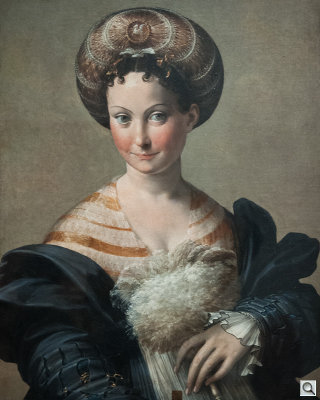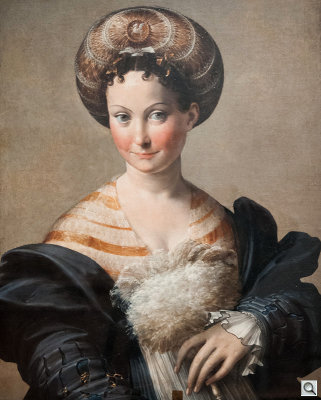Photo Corners headlinesarchivemikepasini.com
![]()
A S C R A P B O O K O F S O L U T I O N S F O R T H E P H O T O G R A P H E R
![]()
Enhancing the enjoyment of taking pictures with news that matters, features that entertain and images that delight. Published frequently.
An Indiscretion




8 September 2014
On a recent visit to the Legion of Honor, we had just finished taking a set of photos of the French rooms when we decided to wander around a bit. To our surprise, we made the acquaintance of a beguiling woman in a dark room. We asked if we could take her photo.

She had just come, without any jet lag, from a show at the Frick. Originally she's from Parma where she lives in the Galleria nationale di Parma. Around 1532, Francesco Mazzola, a native of Parma and known as Parmigianino, brought her to life in his studio.
Walking into that room, we were struck first by her eyes and then her smile. But we were quickly puzzled by the color of the composition. It seemed strangely muted and off key.
You have to live with it a while to appreciate it. The color composition seems designed to flatter the skin tones.
A LITTLE ART HISTORY
Her name reveals very little about her. She was inventoried as Schiava turca (Turkish slave) in 1704 when she was part of Cardinal Leopoldo dei' Medici's collection in the Uffizi.
The designation was inspired, to use the word loosely, by her balzo headdress, which was mistaken for a turban and the linked chain on her sleeve. But a balzo was all the rage among fashionable women in northern Italy in the 15th and 16th centuries. This one is decorated with gilt thread and a medallion of Pegasus.
No one knows who she was -- or even if she was anyone at all. Parmigianino was famous for his pursuit of perfect form. And a painting, unlike a photograph, owes no allegiance to reality.
Aimee Ng, guest curator and research Associate at The Frick Collection, tells her story and makes an educated guess about who she might have been:
Our problem wasn't her identity, though. It was capturing her for ourselves in that dark room. To take her home with us.
THE EXPOSURE
The first was getting a clear shot. She's popular and traffic in the room did not ebb and flow conveniently. So we had to wait quite a while to get her to ourselves.
The second was the glass covering the oil portrait. Protection, no doubt. But reflective. We saw ourselves reflected in her dark dress, in fact. But we couldn't angle the shot or it would have been distorted. The only solution was to back up and shoot her from the middle of the room, to escape the reflective angle of the light.
That, though, put us at 75mm, a mildly telephoto focal length. And closed our aperture down to f5 at wide open. We dared not go above ISO 800 so we had a very slow shutter speed of 1/15 second. But the lens, fortunately, is stabilized, so we knew we could handhold at that speed.
What did we have to lose?
We shot a Raw file, which we later converted to a DNG so we could save the inevitable edits with the file.
It would have been smart of us to shoot a white balance target, too. But we were done for the day and didn't bother. Our mistake. White balance, after all, is not recorded when you shoot Raw.
THE EDIT
When we got back to the bunker, we were happy to see our exposure was not blurred. We had something to work with. And work it was.
Since we were working with a single image, we didn't bother with Lightroom. We worked in Photoshop CC 2014, doing almost all of our corrections in Adobe Camera Raw.
White Balance
We had an unnaturally orange image to work with in Adobe Camera Raw, so we started with white balance.
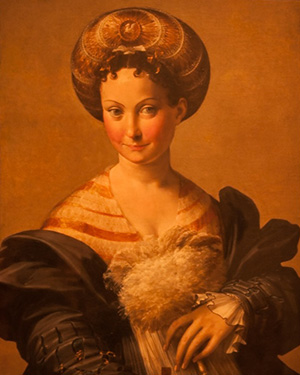
First we tried the presets. Auto looked good. Tungsten looked good, too.
But not perfect. The separation of the background color from the skin tones wasn't quite what we remembered.
So we tried a custom white balance, clicking on various parts of the image we thought should be neutral. The white sleeve, for example.
But doing that, we were restoring color, not reproducing it. And we quickly got a rendering we didn't recognize.
To refresh our memory, we hunted down various renderings on the Web. But that only added to the confusion. The Galleria Nazionale's was particularly unreal but the Frick's, which seems to be the dominant rendering on the Web, seemed too green, especially in the skin tones. Oddly enough, the video seemed closest to what we remember.
We really should have used a white balance target. We had one in our bag, too.
In the end, we tweaked our Custom white balance by slightly warming it while bumping up the exposure a tiny bit. We thought that looked the most well balanced with the best flesh tones.
But went back to find out.
We reshot Sciava Turca with a WhiBal to capture the correct white balance. The gallery seemed even darker on our second visit, though, so it's very difficult to say what "accurate color" is for this image. In fact, our Basic adjustments, which were the same except for White Balance, seem to bring the image into a stronger light.
We've added the corrected image and an enlargement above but appended the alternate image to both enlargements so you can go back and forth between them.
The Crop
The heavy gilt frame was helpful in evaluating our white balance options but you don't see it here because it's a problem.
It's so deep that it creates a heavy shadow at the top of the canvas. Short of using flash -- which is prohibited -- we couldn't eliminate it.
Unless we cropped it.
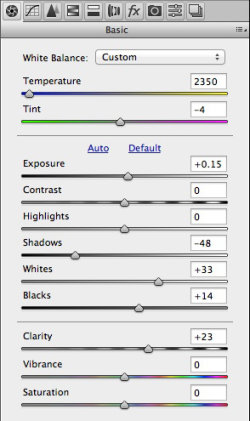
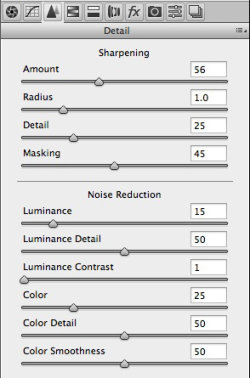
Camera Raw. Our Basic Edits (right) and Noise Reduction settings
Noise Reduction
We added just a bit of noise reduction from ISO 800 to tame the color noise. And we skipped sharpening (even Smart Sharpening). It's a painting, after all.
Lens Distortion
We did tap into Camera Raw's lens distortion tab to enable the profile for our zoom and do a little perspective correction, which turned out to be very minor.
But both things helped.
CONCLUSION
So here she is in all her glory. The beguiling woman we found in a dark room and took home with us.
We had our doubts about how well we had captured her. But since she'll be at the Legion through Oct. 5, we went back (with our camera and a white balance card) to compare our rendering with the reality and shoot a calibrated image.
After all, there's really nothing quite as satisfying as being faithful.
